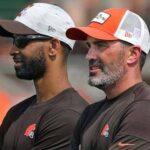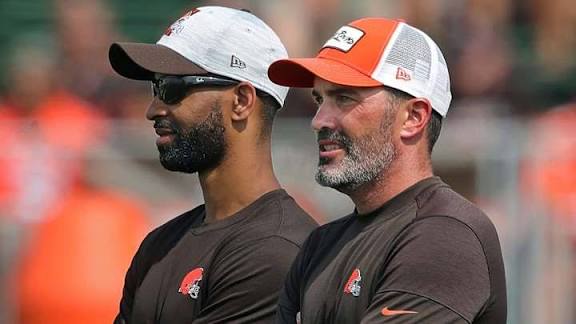On the night before he won the US Open for a second time, Bryson DeChambeau told a gallery of reporters that he had started washing his balls in Epsom salt. No matter how carefully golf balls are manufactured, you see, there will always be errors and imperfections in the mass production of a 1.68in-diameter urethane-covered sphere with 328 dimples. Since the heavy side of an out-of-balance ball will float to the bottom in a solution of Epsom salt and water, DeChambeau has begun marking the top of each ball with a dot to ensure it’s always rolling over itself. “For most golf balls that we get, it’s not really that big of a deal,” DeChambeau explained. “I just try to be as precise as possible, and it’s one more step that I do to make sure my golf ball flies as straight as it possibly can fly, because I’m not that great at hitting it that straight.”
Rory McIlroy faces huge challenge to overcome major US Open heartbreak
Ewan Murray
Not that long ago DeChambeau, a math prodigy who took a physics degree from Southern Methodist University, might have bypassed the ELI5 version for an explanation steeped in jargon and inaccessible to the layman. Instead he served up a made-for-social anecdote lapped up by the media that added a fresh chapter to an eccentric lore that belies the central‑casting appearance of a protypical American Jock™️.
Less than 24 hours later DeChambeau was a two-time US Open winner, joining Jack Nicklaus, Ernie Els, Tiger Woods and Brooks Koepka as the only players since the second world war to win America’s national championship twice aged 30 or younger. After letting a three‑shot overnight lead slip away, DeChambeau fought back from two strokes down on the back nine to see off Rory McIlroy in a heart-pounding box-office showdown for the ages. While the enduring image may be McIlroy’s two missed putts from inside three feet – if not the viral footage of him peeling off the property without a handshake or public comment before lifting off from Moore County Airport only 52 minutes after the winning putt dropped – it was DeChambeau’s sensational 55‑yard sand save on the 72nd hole that cashed in the Northern Irishman’s donations and closed the show.
The 30-year-old DeChambeau was a polarizing figure in the golf world even before going full heel by defecting to the Saudi-backed LIV tour in 2022. He publicly ripped his equipment manufacturer, made brazen proclamations of neutering Augusta and engaged in a petty feud with Koepka, all of which incrementally cost him fan support. But a funny thing happened over the past couple of years as DeChambeau has gone from outcast to one of the sport’s most popular players.
Welcome to Bryson 2.0, the beta‑tested rehabilitated image of America’s champion golfer, a transformation which might have been the story of the US Open even if McIlroy hadn’t choked away his best chance at breaking a decade-long major drought. This wasn’t an accident. The same way he has used science to manifest improvement in his golf – whether it’s bathing his balls in salt water, breaking out a protractor on the greens to line up putts, or using 3D-printed irons at the Masters – DeChambeau has won back fans with a painstakingly remade personality to match his retooled game.
When he first won the US Open in 2020, lapping the Winged Foot field by six strokes with a bash‑and‑gouge style criticised as crude and artless, DeChambeau drove directly to Donald Trump’s Westchester course to celebrate with Don Jr and Eric. He was often petulant in his dealings with the media. It’s not as if he didn’t seek attention, but he carried himself with an off-putting pick-me energy dashed with the spuriously earned superiority of a Kyrie Irving or an Aaron Rodgers, an intent to prove he was the smartest guy in the room.
Four years later DeChambeau is going about things differently. An almost nuclear charm offensive was on full display at Pinehurst with DeChambeau “on” at all times. He interacted with the rollicking crowds that followed his rounds from the 1st to 18th holes and erupted into spontaneous chants, even pausing to sign autographs during his rounds (in defiance of USGA rules) while marching down the fairways or in between holes. He was animated, polite and gregarious, a regular Archbishop of Banterbury engaging in mid-round exchanges with the galleries.
Bryson DeChambeau cuts an animated and engaging figure on the golf course. Photograph: David Cannon/Getty Images
When he stepped off the 18th green for his media obligations after the third round on Saturday, he told the following throngs to meet him on the other side of the range where he signed until the last fan was gone. He all but disavowed his Trump associations after removing the Trump Organization’s logo from his bag shortly after 6 January, normally a cardinal sin in Maga circles, yet remains a darling of the American right, who celebrated his win and took pride in the crowds around the 18th green who brayed “U-S-A!” at McIlroy. To cap it all off after the trophy ceremony on Sunday evening, he waded through the mass of humanity to celebrate with the adoring congregation.
“Tonight,” he said, “I want all of you guys somehow, I want you guys to touch this trophy, because I want you to experience what this feels like for me. You were a part of this journey this week, and I want you to be a part of it for the after-party.”
A working theory is DeChambeau’s second career as a YouTuber has softened his image. Showmanship is a muscle and the grind of building a popular channel, which surpassed 700,000 subscribers over the past week, has forced him to perform in front of the camera with the same dedicated regularity behind his approach to fitness and nutrition. “I mean, my mission is to continue to expand the game, grow the game,” DeChambeau said. “YouTube has really helped me accomplish some of that. Consequently, I think people have seen who I am on YouTube, which has been fantastic, because then I get to play off of it. It just feeds itself out here. They just say things that make me interact and engage.”
The more cynical reading is DeChambeau’s transformation is artificial and pandering, the invention of some nameless image consultancy and stage-managed within an inch of its life. Your mileage may vary but there’s no denying his talent. On a sun-baked Pinehurst No 2 course dotted with glassy turtle-back greens that brought the world’s best golfers to their knees, DeChambeau produced the fewest putts of anyone in the field, curling in the devilish seven-footers that left the majority of the field cursing under their breath. He spoke all week about embracing a patient, conservative golf – he repeatedly described it as “boring” but necessary – while having the situational awareness to know when to divert from the plan. His driver was all over the place in Sunday’s final round but he battled from scratchy lies brilliantly, showing astonishing powers of resilience and compartmentalization. He was a worthy champion.
Sports need stars and golf is hardly an exception. An informal Guardian survey of various hotel workers, bartenders, Waffle House and Oliver Garden wait staff and supermarket cashiers revealed that most people in this corner of North Carolina who didn’t attend the US Open could only name two current professional golfers: Tiger and Rory. If they could name a third, it was usually Bryson, who himself is reaching toward mononym status if not quite a household name. In the simplest of terms, Sunday afternoon’s heavyweight showdown down the back nine of the US Open – offering the kind of gripping theater and heightened drama that gets casuals under the tent and creates lifelong fans – wouldn’t have been possible without him, removing all doubt that professional golf is richer with DeChambeau in the frame.

